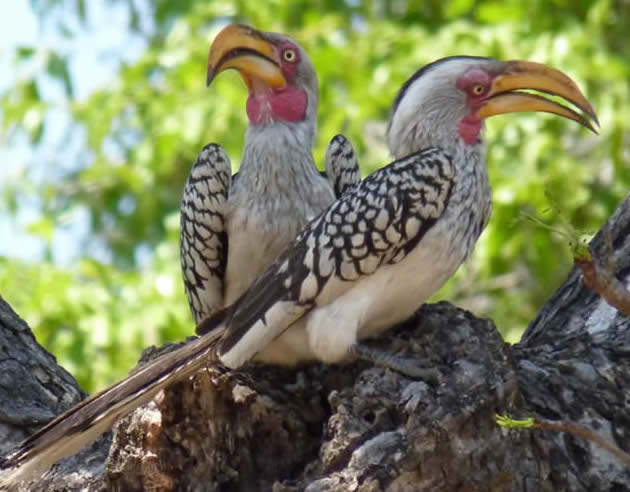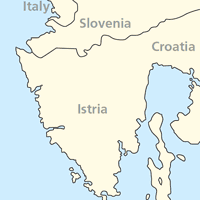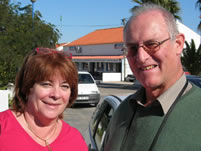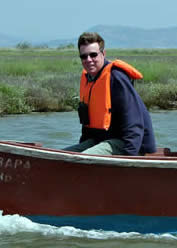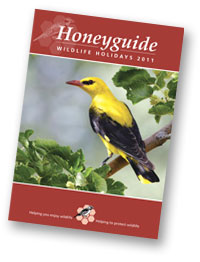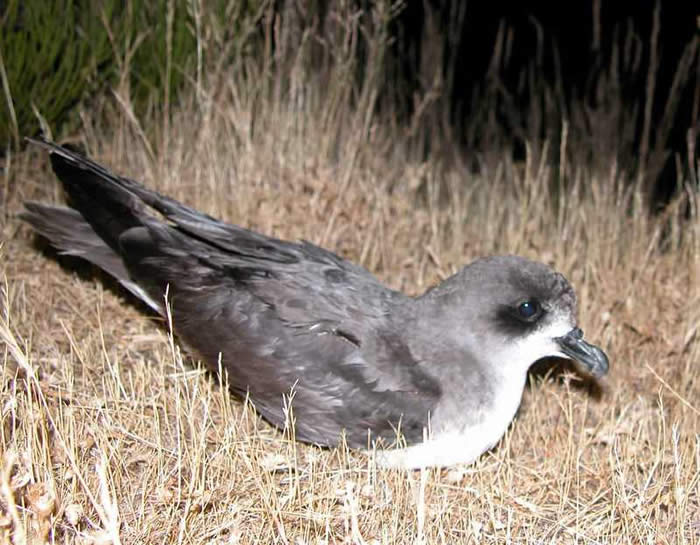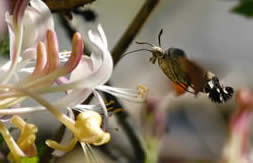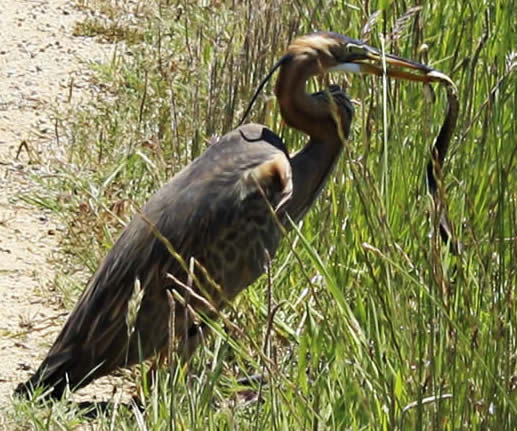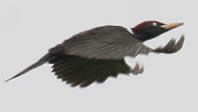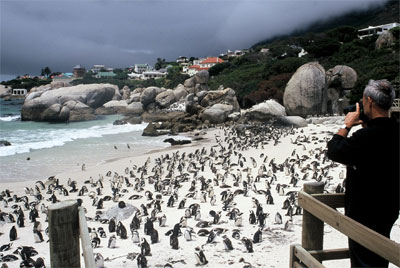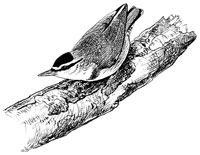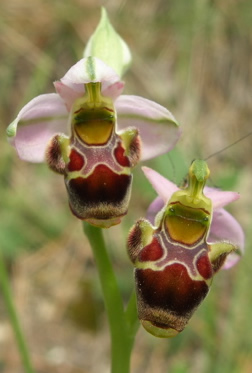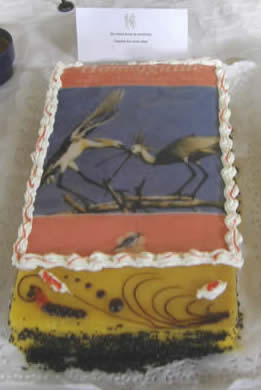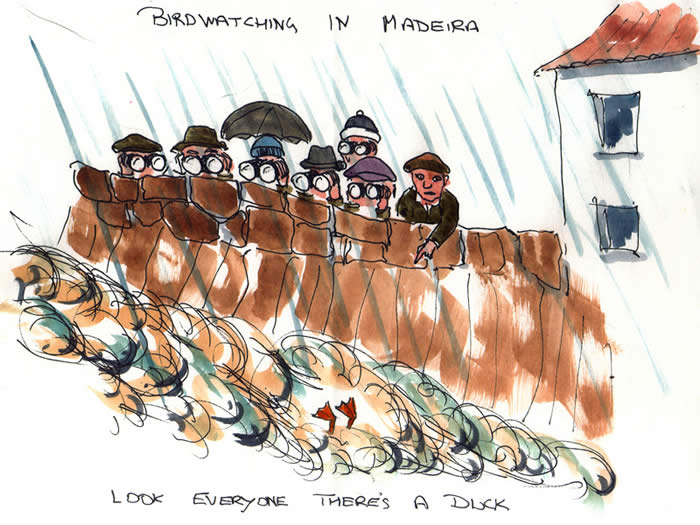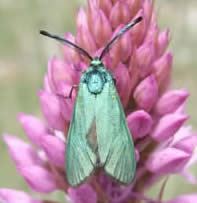Honeyguide news archive 2010
Extremadura leader Martin Kelsey has a regular visit to the UK for the Birdfair at Rutland Water in August where he helps to run the Extremadura stand for the Junta (regional government). In November he was also in Woodbridge, Suffolk, doing a talk about his local patch and meeting Honeyguiders, present and, we hope, future. If you'd like to keep up with Martin's wildlife news he has an excellent blog. Recent entries include 'scores of sandgrouse' and 'gems in rocky places' about wallcreepers.
I counted up and found that a private party – friends and regular Honeyguiders – in 2011 will be our 17th group in Berdún in the Spanish Pyrenees. Most of these were based at the Painting School, and since that closed we stay at Casa Sarasa, which has a spendid new website www.casasarasa.com. Honeyguide's new Berdún web page offers some ideas that Peter Rich is developing, including photography courses and walking parts of the Camino de Santiago in the foothills near Berdún. It may well be that there aren't many Honeyguiders who haven't been to the area and these will strike a chord for a return visit.
In early November I made a successful recce visit to the Peloponnese peninsula in Greece. (Other ideas for 2012 are being explored ... watch this space.) It's very promising and should make an interesting new holiday in spring 2012. There's a full recce report here, which includes details of cyclamens, colchicums and five crocus species among a range of autumn flowers, plus pictures of two very different lizard species (one is below). Perhaps the most surprising natural history discovery was wild boar, or rather extensive rootings in one area. Though known to be there by local people and a local guide book, three field guides to mammals in English and some website maps show wild boar as absent on the Peloponnese peninsula.
Peloponnese wall lizard. The male has distinctive blue spotting on the flanks.
Posted or updated by Chris Durdin, 30 November
Kruger National Park: Honeyguider Brennan Aunger, who has just returned from South Africa to his home in Germany, writes: "This was my first wildlife holiday outside Europe, and that I saw over 200 new birds speaks for itself. However for me the most memorable experience was the close views of mammals. Animals seem to accept vehicles as part of the scenery and appear unconcerned about being photographed! My highlight: a close encounter with a leopard on one of the optional night-drives organised by the park staff."
Your South Africa: as our three South Africa holidays come round roughly in turn, so all too infrequently, earlier this year we launched 'Your South Africa' for anyone who wished to visit at a time more of your own choosing. Geoff Crane has prepared four more itineraries with Honeyguiders in mind, and these are now on this web page. The four are: Cape Town & spring flowers; Cape Town & the Garden Route; Kgalagadi (=Kalahari) Transfrontier Park and the Augrabies Falls National Park; and St Lucia & Zululand and the Drakensburg Mountains. Our South Western Cape holiday is in our main programme for autumn 2011, and there's a discount of £100 for anyone that books by the end of this year.
Posted by Chris Durdin, 12 November
October news
We have two new web pages this month. The word truffles may hint at a new cookery thread (perhaps an idea?), but it's far from that. Paul Tout, our leader in Istria (Croatia) traces the connection between Venice, timber and truffles that has shaped the peninsula's landscape, culture and wildlife. |
Timber and truffles in Istria:
You can go to both of these new pages via the main Nature Notes page. |
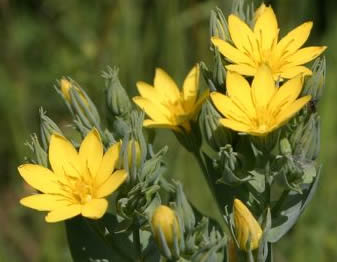 |
The second looks at how a double-W often seems to crop up in wildlife names, and hardly ever elsewhere. Or is that wrong? Examples include slow-worm, yellowwort (left) and ... well, you'll have to click here to read the rest.
|
News on the Honeyguide leadership team for next year. Ivan Nethercoat will co-lead with Chris Durdin again in the French Pyrenees in June next year. Maureen Gibson will join Chris Gibson as co-leader in Menorca. A new name for the Honeyguide team, on the Poland page, is Ian Barthorpe. Ian is the RSPB’s Marketing and Publicity Officer on the Suffolk coast, based at Minsmere and covering lesser known reserves such as Snape, Havergate Island and North Warren. More about Ian here.
Departures: for our first three Algarve holidays, Deric Brown was the warm, extrovert host at the Hotel Belavista in Praia da Luz, hospitality personified. For the fourth, in April 2009, he was my co-leader. In the words of Brian Anderson, my co-leader in the Algarve with the first three groups, "He was a larger than life character who will be sorely missed by all who knew him." There is a picture of Deric with his wife Kate here. John Minihane at one stage booked four Honeyguide holidays in 2009 - that's a record - though health challenges meant he made it to just two of these, namely Algarve (with Deric and me) and a return visit to the Danube Delta. This year he joined the Poland group, and thoroughly enjoyed it, especially Artur's hospitality. He was a great champion for the Suffolk Wildlife Trust, especially its Hen Reedbeds nature reserve by his home town of Southwold. Steve Henson (1956-2010). It was a terrible shock during August to hear that Steve, until recently a regular Honeyguide leader, collapsed and died while on field work in the Fens, with a blood clot on a lung, we understand. Many will have known Steve from holidays in Lesvos, Slovakia and especially Eastern Greece, a holiday he set up for us after he'd stayed at Dadia to do survey work. As Rob Lucking remarked, Steve was also the only person we knew who actually liked retsina! Regular Honeyguider Sandy Watt, who was with us in Extremadura in March, died in September, on what would have been his first day with us in the French Pyrenees. Marie has our deep sympathy.
Posted by Chris Durdin, 12 October
Honeyguide's brochure for 2011 was been posted from our mailing house have arrived around the 17 September if you're on our mailing list. If your brochure hasn't reached you, it's best not to wait - please ask for another. For anyone else who would like a copy, please contact us. You can also look at a PDF of the 2011 brochure here. More on our Calendar page.
Strikes hit French Pyrenees holiday
The
air traffic control strike in France meant cancelled flights to both Pau and Toulouse, and calling off our fully booked holiday based at Gèdre. I've been getting regular bulletins from two Honeyguiders who were there as part of a longer stay in France, and they have been seeing lots of birds and butterflies. This helps to confirm it's a good place to visit in September, so we hope to try again in autumn 2012 as well as June 2011.
In August, a massive forest fire on the island of Madeira killed several breeding adults and 65% of this year’s chicks of Zino’s Petrel, Europe's rarest seabird. Read more here from BirdLife International, which has launched an appeal. Our Madeira holiday has been contributing to Zino's petrel conservation for several years (here). We'll also be happy to accept donations through the Honeyguide Wildlife Charitable Trust which, similarly, we can top-up with Gift Aid and route the money to the sharp end for Zino's petrel conservation in Madeira.
Chris Durdin, 13 September 2010, updated 12 October
'Vuvuzelas could disturb sensitive birds' says one story on BirdLife International's new BirdLife Community web pages. Well, that's the headline: analysis in the story sensibly puts that idea in serious doubt.
These pages publish news stories from the BirdLife network, many of which Honeyguide supports. You can also sign up for regular news updates.
* * * * * * *
Here on the east of Norwich, there were hummingbird hawkmoths at school then at home on 9 July, coinciding with the run of hot weather. Last year was a bumper one for painted ladies; could it be that 2010 will be one of those years with lots of hummingbird hawkmoths migrating north to the UK? You can enter sightings on the Butterfly Conservation website.
* * * * * * *
"A small group finally made it to Menorca in May, a month later than anticipated due to the volcanic ash cloud. But every cloud has a silver lining," says leader Chris Gibson.
"Yes, most of the migrant birds had passed through, and almost all the orchids and other early flowers were finished. But the special plants of the island were superb, with some magnificent Balearic dragon-arum flowers and several of the endemic 'vegetable hedgehogs' in full flower, something we have never seen before, along with cerise swathes of wild gladiolus. And the breeding birds were there in force: turtle doves and spotted flycatchers everywhere; stone-curlews every morning; my best-ever Menorcan purple gallinule; and some wonderful encounters with bubbling bands of bee-eaters. There were a few surprises: a band of spotless starlings; a western olivaceous warbler around our garden; orphean and spectacled warblers; and none of us will ever forget the sight of a purple heron catching (but failing to kill and eat) a viperine snake, no more than five metres from the vantage point of our minibus!"
Updated 13 July 2010
Last June, bee orchids popped up opposite Norwich City Football Club (see News 2009 and the Eastern Daily Press. I looked on Monday afternoon and couldn't find any this year. The Big Yellow Storage meadow was cut in late May, which was unhelpful, though I suspect with the cold winter and late spring that there was still time for them to appear. No doubt they are there in the soil, or the odd leaf I couldn't find, and will pop up another year. Today I found three just coming into flower on Carey's Meadow, roughly halfway between the Football Club and Thunder Lane. That's as well as those pictured on the sign on the gate! |
This shows that they are running about 10 days behind last year's bee orchids, which were nearly fully out when I photographed them on 10 June 2009. Bee orchid, above and right |
Updated by Chris Durdin, 17 June 2010
Lesvos is one of few places to boast two 'where to watch' birdwatching books. Honeyguide's Lesvos leader Rob Lucking writes about both books here. We still have places on our holiday here in autumn this year, added to the programme recently after volcano ash hit spring holidays. |
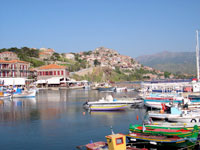 Molivos harbour (Rob Lucking) |
The Spanish Pyrenees with a difference? Our regular holiday in Berdún has a group booked for next spring, but we are wondering about seeing this area in a rather different way by walking parts of the Camino de Santiago in Aragón region that are close to our base at Casa Sarasa in Berdún. I think this would lend itself to an autumn holiday, and though this year is possible it may be more realistic to look at, say, October 2011. Many details are to be worked up, but this website gives a good feel for what we could do. Or see Peter Rich's photos here. We'd expect to have a Honeyguide natural history leader and for the all-in price with flights etc to be roughly the same as other week-long Honeyguide holidays. It would involve considerably more walking than a typical Honeyguide holiday, though we'd expect to fine-tune the plans to get the best out of the natural history as well as the lovely buildings of the Pyrenees foothills and gorges. At this stage, it would be interesting to know if this appeals to anyone, before we take it further. See also our Berdún web page.
Updated by Chris Durdin, 9 June 2010
Spring was a little late in the Dordogne, as for so much of Europe - Greece and the south-east excepted. So the early orchids were exceptional: green-winged, early spider, lady and sombre bee orchids especially. After 10 years of holidays here, it was surprising to 'write-in' five new birds onto the checklist. Little egret, hen harrier, little owl, kingfisher: nice birds, but not great surprises. But best was black woodpecker, well west of its published range. We had brilliant views as two flew round us, and group member Bruce Bennett took these photos. The holiday report is here.
Honeyguide's first group in Poland went well. Helen Crowder tells more.
"The ‘wow’ moments started before we even reached our hotel in Biebrza – thousands of white-winged and other marsh terns hovering over their habitat, a pair of Montagu’s harriers in the background, and a few minutes later an elk in the woodland alongside the bus!
"The most obvious birds seen easily from our friendly, rural hotel were common cranes and white storks, while icterine warblers sang their manic, squeaky-toy song from silver birches in the garden and once a spotted eagle flew over (its tracking device was diagnostic!) Aquatic warblers, globally threatened and declining, were breeding nearby, as were Savi’s and grasshopper warblers, and the general rule that you hear but don’t see certain species was thoroughly thrashed as, thanks to our guides, we saw these and many others, including a corncrake, very well indeed. It is impossible to select a single highlight as there were so many, but my particular favourites were white-spotted bluethroats, scarlet rosefinches, lekking great snipes, perfect lady's slipper orchids (in a mosquito-infested wood, not itself a highlight), three-toed woodpecker with its yellow crown, listening to the thrush nightingale’s song and becoming aware of its subtle difference from the nightingale’s, the soothing sound of fire-bellied toads at night, breakfasting on delicious pancakes in the morning, and having brief but exciting views of bison grazing at the forest edge. A week is not enough. Poland is a wildlife haven."
Updated by Chris Durdin, 4 June 2010
Lesvos in autumn: with one and a half holidays lost in April due to cancelled flights, we thought another opportunity to travel with Honeyguide before next spring would be a good idea. Rob Lucking, who was due to be with me in Crete, is also our man for Lesvos, where we ran an autumn holiday in 2007, so a return to this Greek Island off the coast of Turkey was the obvious choice. The dates are 23 – 30 September, and all the details are on our Lesvos pages. These include, unusually, the itinerary and holiday information sheets that are normally posted on request and for those that book, so it's all there for you to read and consider while I am away in France, volcano dust permitting, from tomorrow.
To match the 'lost' Crete holiday, there is no single supplement for this week in Lesvos holiday and the price of the holiday is also the same as it was for Crete. We'll need a minimum of four to run this holiday, but we have three already so we are almost there even before the new holiday is 'official'.
The lure of orchids: when I started botanising, I was puzzled by why orchids seemed to get more attention than other flowers. But their intricate beauty, identification puzzles and extraordinary growing arrangements in combination with a fungus have drawn me under their spell. Now the story gets more fascinating still: new research shows that they tempt their pollenating insects with pheromones as well as their lookalike design. Read the story here
Updated by Chris Durdin, 5 May 2010
* * * * * * *
Many of you will remember the RSPB's Bob Scott (pictured, right) and his enormous passion for birds and conservation. A year since his untimely death, to commemorate Bob's life and to aid trans-Saharan migrants, www.birdguides.com has launched a quiz that you can either download or order by post. It covers many forms of natural history and has four excellent prizes for the winners.
Stork webcam: the stork is back in front of the webcam near Honeyguiders Karin and Brennan in Markt Schwaben, Germany. One young fledged, 26 July.
BirdLife Malta has an online petition to "demand that Malta respects the EU law and stop killing of protected birds". You can sign it here
Honeyguide has new web pages on Crete Bird Reports here and wildlife mysteries, like the bug (top right), here
Updated by Chris Durdin, 25 April 2010
* * * * * * *
Volcanic dust and flights: the rapidly changing situation has taken a turn for the better, with flights resuming in the UK from 22:00 on Tuesday. For the latest information, please check the NATS website.
April is a busy time for Honeyguide so this has been a bad time for flights to be cancelled for nearly a week.
Our Menorca holiday, due to leave last Friday (16 April) was cancelled. Part of the group will instead be going 14-21 May, and it may be possible for others to join that group.
Most of the Central Portugal group has, at last, arrived home. Since Saturday, when the holiday finished, after a night in Lisbon most of the group, 11 people, went by train overnight from there to Madrid. (Two had set off independently on the Saturday, with great success, and two stayed on in Lisbon). Then on the Monday afternoon, another train to Barcelona and a hotel by the station. On Tuesday morning they went north by train to Cerbère, near Perpignan, just over the border in France. Travelling conditions were congested and challenging, including the hangover from a French railway strike, so we arranged for them to be collected from there in two vehicles by Gilles, our coach driver from the Dordogne. Late Tuesday night they arrived at our Dordogne holiday base at Castang where they spent the night and recharged batteries in the good care of Cathy and Keith (indeed two stayed on there for a further day). Then, on the Wednesday, more train travelling to Calais, a long and cold wait for a ferry and the remaining nine were home in the early hours of Thursday.
The group for Crete 20-27 April (with me) was cancelled.
Happily the group to Eastern Greece left for for Athens on Thursday evening (22 April) and are safely in Dadia, the holiday having seemed highly doubtful early last week.
Updated by Chris Durdin, 14:25 on 24 April 2010
* * * * * * *
This autumn's French Pyrenees holiday is now one day earlier than the brochure dates, namely 7 - 14 September, due to changes to flight schedules from Stansted to Pau Pyrenees. There are two places on this holiday, preferably flying from Gatwick or Bristol to Toulouse.
 |
BirdLife International estimates that more than 200,000 seabirds die each year at the hands of EU fishing boats. Please sign its pledge here to the new Commissioner for Maritime Affairs and Fisheries, Maria Damanaki, urging her help to stop this slaughter. |
A first black woodpecker for the UK in Cumbria was reported to BirdGuides last week. The lady was cross-examined and the description was spot on. It turned out that BT is rather protective of its Cumbrian telegraph poles, and has for years been placing black woodpecker models on them to deter great spotted woodpeckers.
Updated by Chris Durdin, 2 March 2010
Madeira news: Honeyguide's group on Madeira coincided with the storms and mudslides (see BBC report here) that affected the island; the group was safe and they are now back home. The capital Funchal and the south was hit worst. The group was staying near Santana in the north, though was heading into Funchal on the worst day of rain. Leader Hugo was driving and decided that they would be wise to return to the north of the island. He had passed his video to Honeyguider David Melzack, in the front seat of the minibus, who captured the striking shots with Hugo's camera here (this link may not work in some web browsers). The 'boiling' river was taken by Hugo outside the vehicle. Inevitably, the weather meant the group's itinerary was changed and wildlife sightings were affected, but highlights still included many Madeira firecrests and being surrounded by a school of pilot whales at sea.
Updated by Chris Durdin, 5 March 2010
We have three new web pages, and they could hardly be more different.
| Orchids are a great feature of our Dordogne holiday, with 12 species at our base at Castang and another dozen not far away. Enjoy them online here or, better still, there are a few places remaining on this holiday. | |
| A cuckoo's song in spring is a minor third. But this musical interval crops up elsewhere in nature, too. Can you shed light on this mystery? Thoughts from naturalists or musicians are equally welcome on our latest page in our nature notes. |  |
| ATOL matters: the initials and acronyns around holidays with flights (ATOL, ABTA, IATA etc) can be confusing. With Honeyguide, consumer protection comes from our Air Travel Organiser's Licence (ATOL), from the Civil Aviation Authority. The Government is now consulting on extending the respected and effective ATOL system to include non-flight packages, which we'd welcome. More on our new ATOL web page. |
|
|
Biodiversity is life: how much do you know about conservation challenges for the house sparrow, red squirrel, tansy beetle and black poplar? |
It's the International Year of Biodiversity and Natural England is highlighting England’s native plants and animals for which conservationists are making thedifference between survival and extinction. See 'species of the week' - click here to read more. |
Updated by Chris Durdin, 4 February 2010
Climate change: there are clear changes in the natural world, like expanding ranges of Cetti's and Dartford warblers, little egrets and speckled wood butterflies. Naturalists know how wildlife responds to these subtle changes, so gives us a head start in recognising the reality of climate change.
The wintry weather has brought a few wildlife highlights too, but inevitably it's prompted a few comments such as 'so much for global warming'. This may be in gentle fun, puzzlement or can be cynical. Honeyguiders have a role in combatting cynicism: the evidence for climate change is too clear to dismiss, even though it's modest at the moment compared with what is predicted. Some nuggets to lob back at doubters: there's a difference between weather (today) and climate (long term trends); polar ice and glaciers are retreating; we've seen or heard about many severe weather events in recent years.
Our first 1,000 Honeyguide lapel badges have finally run out, but we have more. Our suppliers didn't get the best of colour matches for the pink honeycomb but they are pretty striking-looking. You're welcome to one if you've lost yours or just fancy the new one in deep pink.
Weevil threatens Cretan palm
The red palm weevil Rhynchophorus ferrugineus poses a serious threat to the endangered Cretan palm Phoenix theophrasti, which occurs only on Crete
and in south-western Turkey. Honeyguiders know the grove of Cretan palms at Souda, just west of Plakias. Members of Flowers of Crete have found specimens of the weevil elsewhere on Crete, alerted the authorities and set up an online petition to raise awareness of the weevil's threat. To read and sign the petition click here
Updated by Chris Durdin, 12 January 2010
Have I got old news for you? . . . News 2024 . . . News 2023 . . . News 2022 . . . News 2020-21 . . . News 2019. . . News 2018 . . . News 2017 . . . News 2016 . . . News 2015 . . . News 2014 . . . News 2013 . . . News 2012 . . . News 2011 . . . News 2010 . . . News 2009 . . . News 2008 . . . current news page.




